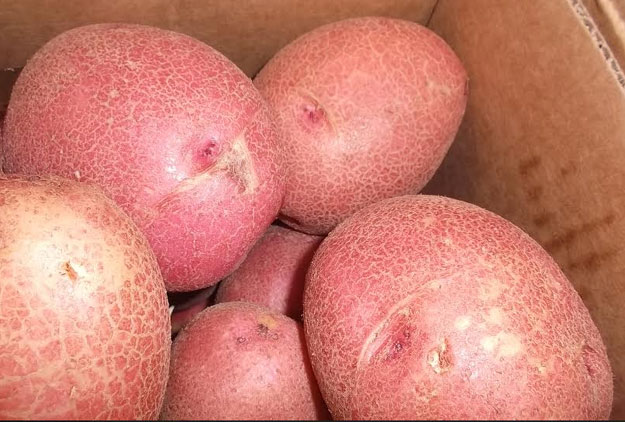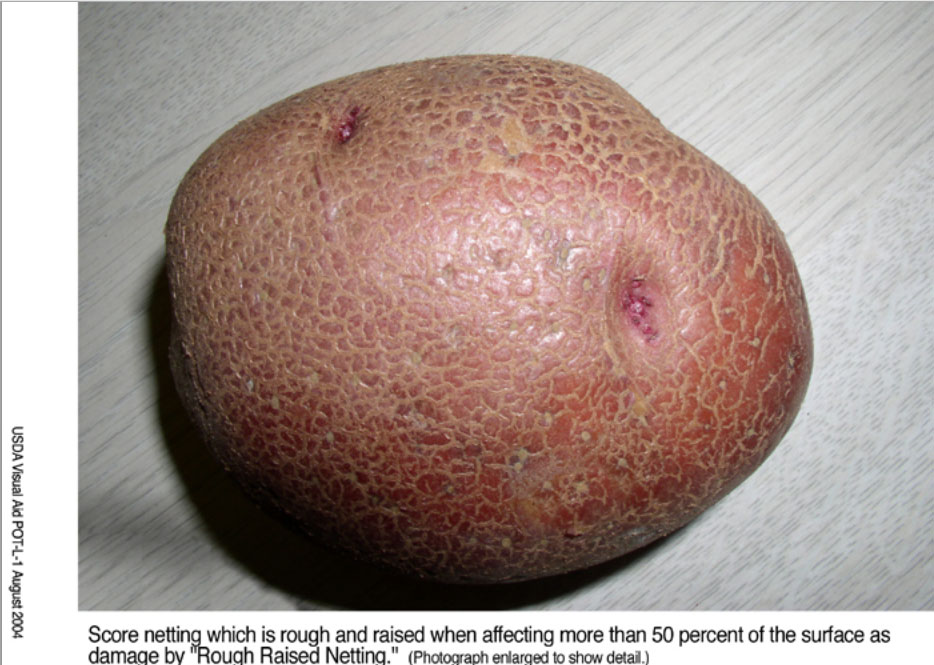This defect may fall under the category “What difference does it make,” but there is definitely confusion among all inspectors, including USDA inspectors.

These potatoes, from California, were recently inspected and rejected at a warehouse. But what is the defect? Some possible defects come to mind, Russeting, Netting and Surface Cracks. The good thing, all three of these defects are quality defects, meaning they will not change, progress or become worse. But, typical of the USDA, the scoring guidelines for each of the similar defects is not always the same. For instance, if you call the defect Russeting or Netting, more than 50% of the surface of the potato must be affected. If you call the defect Surface Cracks then you only need 20% or 33% of the surface affected, if the cracking is rough or deep or smooth and shallow. So identifying the defect correctly does affect how the defect is scored or not scored.
The USDA’s own Inspection Instructions state the following:
Rough Raised Netting: Netting affects the skin of potatoes; it may be fine, raised and/or rough. However, netting is only scorable when it is rough and raised. Score as damage when netting is rough and raised and more than 50% of the surface. Rough raised netting is never scored as serious damage.
Russeting: Russeting which occurs naturally on russet varieties, or on some red and white varieties, is not scorable. Only score russetting when not characteristic for the variety. Score non-characteristic russeting as damage when affecting more than 50% of the surface area in the aggregate. Do not score as serious damage.
Surface Cracks: Surface cracks are the superficial cracking of the skin of some varieties of potatoes and should not be confused with russeting. The cracks are generally wider and more pronounced than russeting. Scoring Guide Areas affected by fine net-like cracking should be ignored. Damage: When smooth shallow cracking affects more than 1/3 of the surface, or When rough deep cracking affects more than 5% of the surface area. Serious damage: When rough deep cracking affects more than 10% of the surface.
Confused? So russeting occurs naturally on some red or white varieties of potatoes, but should be scored as a defect when not characteristic for the variety. How does one know when it is characteristic and when it is not? And Surface Cracks may commonly be confused with Russeting? Ignore fine net-like cracks? But doesn’t Russeting appear as fine net-like cracks? And to make matters worse, the USDA’s own visual aid book lists Surface Cracks and Netting as the same defect.

The image above is the USDA’s lone official visual aid for damage by Surface Cracks/Netting, even though the USDA has different scoring guidelines for Surface Cracks and Netting.
To add further to the confusion, in 2004, the USDA developed a new visual aid depicting Netting.

This visual aid makes no mention of Surface Cracks.
So when its all said and done, I would say the potatoes in the first image shown here would be scored as damage by Rough Raised Netting if more than 50% of the surface is affected. Hopefully someone in the USDA will clear up the confusion.

2 Comments on “Potatoes- Netting”
This condition is prevalent in the Ruby Red variety. I have seen the condition become less affluent from the same fields as the tuber cures and the ground becomes drier. Growing climates and conditions will dramatically be different in every area as well as the soil type they are grown in. You can call it Alligator skin.
Thank you for another wonderful post. The place else could anyone get that type of info in such an ideal way of writing?
I have a presentation next week, and I am at the look for such information.